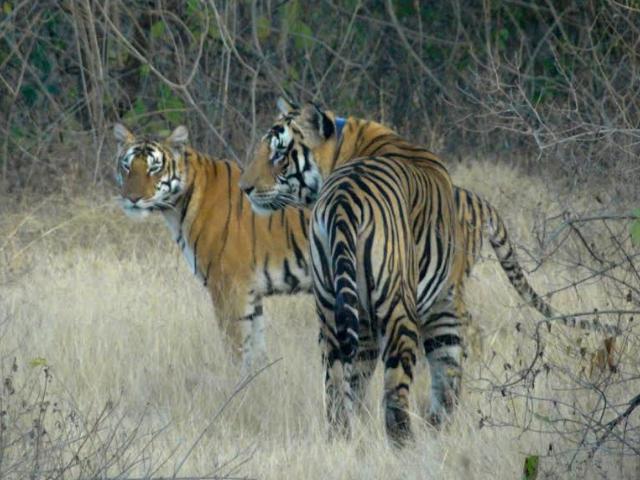Death of a tiger in the wild is natural until it is poached. And most of the big cat die anonymously embracing death somewhere deep in the woods. Many times even their dead bodies are not recovered. But the prince of Panna tiger reserve - P111 who later became the king of the jungle seem to have served the purpose of his life before his death earlier last week. The wildlife lovers and the park management remembered the striped cat for the revival of tiger population in Panna tiger reserve from zero to about 70 today. P111 was one of the four of the first litter of T1 and T3 translocated to Panna in 2009 when all its tigers were poached in 2008. Birth of P111 indicated success of tiger reintroduction and revival of big cat population in the tiger reserve, now facing a big threat of disintegeration because of Ken Betwa Link Project (KBLP).
The King of Panna
In his life span, P111 fathered over dozen tigers in the last one decade or so and the tiger population in Panna grew from 0 to over 70. Known as Raja of Rajaberia or King of Rajaberia, P111 had replaced his father T3 from his territory and was the dominating tiger of Panna ruling a large swathe of jungle from core area to Hinauta. P111 was found dead on June 9 evening. Both his parents T1 and T3 are still alive. The female T1 was translocated from Bandhavgarh national park while the male T3 was brought from Pench tiger reserve in 2009 as a part of tiger reintroduction program in Panna.
Also Read: Coal Mining All Set To Threaten Tiger Corridors Around Tadoba
One more tigress-T3 was also air-dashed by a chopper from Kanha tiger reserve. After successful mating of T1 and T3, P111 and three more cubs were born in April 2010. For about 18 months, the prince remained with his mother T1. After honing the skills of hunting and learning the art of hiding necessary for surviving in jungle, P111 separated from his mother T1. Soon after attaining adulthood, the ferocious full grown glittering golden yellow and prominently black striped tiger pushed off his father T3 from his territory declaring himself the king.
Father's Tantrum
A major drama unfolded before the birth of P111. Soon after translocation of his father T3 on November 14, 2009, he left Panna leaving the wildlife experts wondering. In a major “homing instinct”, he stared moving towards Pench tiger reserve from where he had been transloated to Panna tiger reserve. “The tiger was brought to Panna on November 14 to mate with two tigresses translocated to revive the big cat population in Panna but he moved out of the reserve by November 25 and remained untraceable for a month, leaving wildlife scientists baffled,” the then Principal Chief Conservator of Forests (Wildlife) RS Negi, had commented amidst the tiger's march towards Pench Home instinct, biologists said, is the ability of an animal to perceive direction — beyond the usual human senses. It helps the lost animal to return to its home or owners.
Also Read: Future Tense: Turbulent Time Ahead for Panna Tigers
According to wildlife experts at the prestigious Wildlife Institute of India (WII) , “this ability can be attributed to the animal’s sensitivity to the earth’s magnetic field.” T3 had crossed hills, fields, human habitations and rivers and was moving towards his home at Pench before he was located and trapped after being tranquilised. He was kept on an enclosure for a month or so before successful mating with T1 followed by the birth of P111.
Banner Pic: P111 with a mate . Courtsey Panna Tige Reserve




Comments
Post a Comment